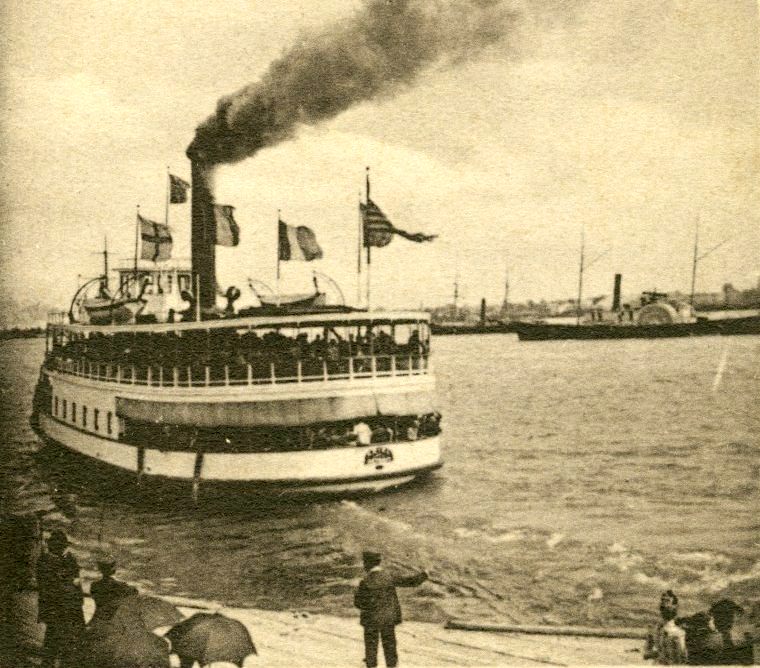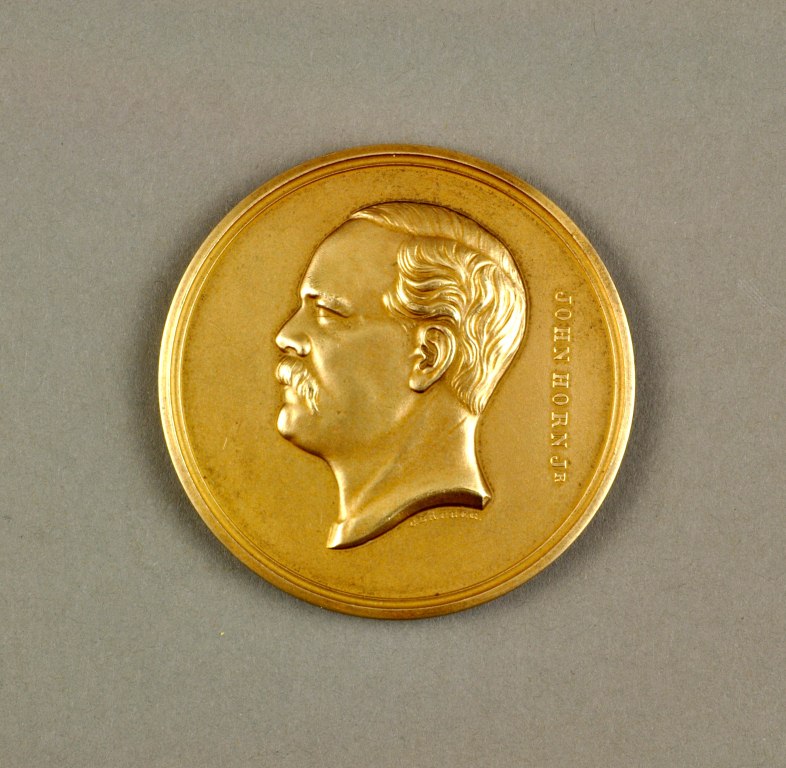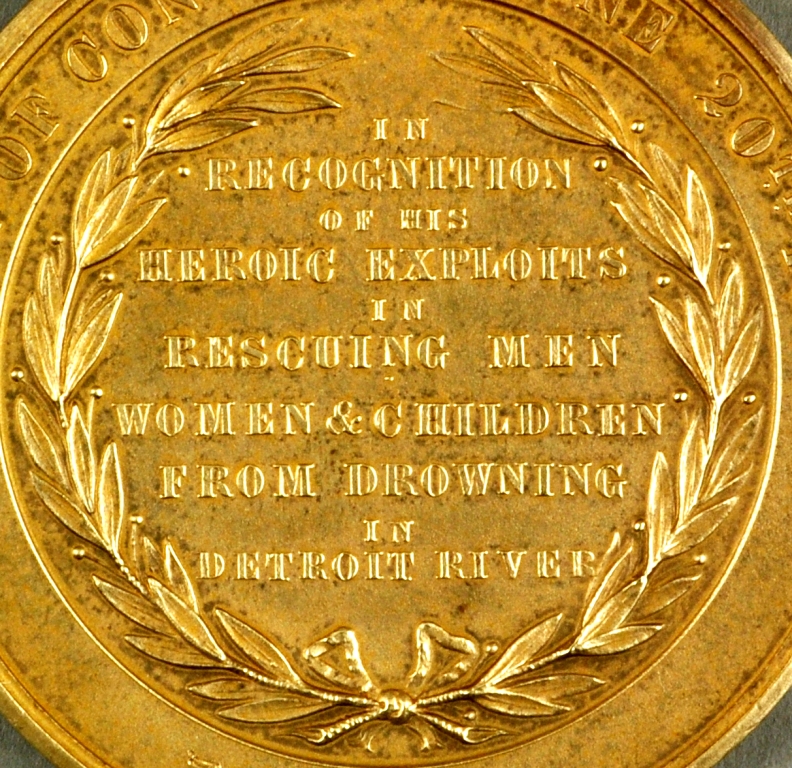The Lifesaver
 Born in Devonshire, England in 1843, John Horn Jr. immigrated to the United States in the early 1860s. His father operated a tavern at the base of Woodward Avenue at the public wharf. John Jr. was described as a large man with broad shoulders and impressive physique. He worked for his father as a bartender for a short time, and was involved in the Detroit Baseball Club where he gained notoriety as an outfielder and batter. However, young John Jr. was always drawn to a life on the water. After becoming a Great Lakes captain he purchased the steamboat Favorite and operated a ferry from Detroit to Windsor in 1867. Horn’s ferry business flourished and in 1877 he joined his steamer Garland with three other competing ferries to form the Detroit Windsor Ferry Company. John Horn’s athletic ability and good nature positioned him for a more meaningful purpose on the Detroit River as a lifesaver. Multiple accounts exist of his heroic exploits to save people who had fallen into the river. His first rescue was a Mr. Manning of Windsor in May of 1865. Horn rescued nine men from the disaster of the Detroit and Milwaukee Railroad Depot on April 11, 1866. After saving the nine men, Horn was too exhausted to swim and sixteen men perished in the water after the disaster. In March of 1873 Horn struggled for more than seventeen minutes in the water, swimming around floating ice and slush, to reach Miss Louise McKenzie. As a result of that endeavor, he spent several weeks recovering from frostbite, hypothermia, and pneumonia. On July 4, 1873, a crowd of more than 500 stood by and watched as the daughter of Mr. F. Barlow fell from a boarding plank and began to sink into the river. Horn was summoned from his house near the wharf and ran to the scene and was the only person willing to jump in to save the young girl.
Born in Devonshire, England in 1843, John Horn Jr. immigrated to the United States in the early 1860s. His father operated a tavern at the base of Woodward Avenue at the public wharf. John Jr. was described as a large man with broad shoulders and impressive physique. He worked for his father as a bartender for a short time, and was involved in the Detroit Baseball Club where he gained notoriety as an outfielder and batter. However, young John Jr. was always drawn to a life on the water. After becoming a Great Lakes captain he purchased the steamboat Favorite and operated a ferry from Detroit to Windsor in 1867. Horn’s ferry business flourished and in 1877 he joined his steamer Garland with three other competing ferries to form the Detroit Windsor Ferry Company. John Horn’s athletic ability and good nature positioned him for a more meaningful purpose on the Detroit River as a lifesaver. Multiple accounts exist of his heroic exploits to save people who had fallen into the river. His first rescue was a Mr. Manning of Windsor in May of 1865. Horn rescued nine men from the disaster of the Detroit and Milwaukee Railroad Depot on April 11, 1866. After saving the nine men, Horn was too exhausted to swim and sixteen men perished in the water after the disaster. In March of 1873 Horn struggled for more than seventeen minutes in the water, swimming around floating ice and slush, to reach Miss Louise McKenzie. As a result of that endeavor, he spent several weeks recovering from frostbite, hypothermia, and pneumonia. On July 4, 1873, a crowd of more than 500 stood by and watched as the daughter of Mr. F. Barlow fell from a boarding plank and began to sink into the river. Horn was summoned from his house near the wharf and ran to the scene and was the only person willing to jump in to save the young girl.  In 1871 the City of Detroit awarded Horn a medal for saving more than 110 people from the Detroit River. Unfortunately, the medal was lost in the river during the saving of Miss Louise McKenzie. As word spread of Horn’s lifesaving ability, the United States Congress decided to award John Horn Jr. with a Congressional Gold Medal for heroism. Prior to that time, Congress had awarded medals for heroism in sea water rescues. Horn proved that the Great Lakes and inland rivers were equally as dangerous and possessed brave rescuers as well. The solid gold medal featured the profile bust of Horn on the front and an inscription on the back that read “By Act of Congress June 20, 1874, in recognition of his heroic exploits in rescuing men, women, and children from drowning in the Detroit River.”
In 1871 the City of Detroit awarded Horn a medal for saving more than 110 people from the Detroit River. Unfortunately, the medal was lost in the river during the saving of Miss Louise McKenzie. As word spread of Horn’s lifesaving ability, the United States Congress decided to award John Horn Jr. with a Congressional Gold Medal for heroism. Prior to that time, Congress had awarded medals for heroism in sea water rescues. Horn proved that the Great Lakes and inland rivers were equally as dangerous and possessed brave rescuers as well. The solid gold medal featured the profile bust of Horn on the front and an inscription on the back that read “By Act of Congress June 20, 1874, in recognition of his heroic exploits in rescuing men, women, and children from drowning in the Detroit River.”  Repeated injuries and sickness from the cold water rescues took their toll on Horn. His health began to deteriorate and he suffered from rheumatism. He claimed to have lost more than $1,000 in clothing from the many rescue attempts. His ferry business failed to compete with bigger and more efficient boats. In 1904 Horn’s gold medal was reported stolen from his home in Detroit. Congress had never authorized a second minting of a gold medal, but they took into account Horn’s condition and his unquestionable contribution to humanity and for the first time a Congressional Gold Medal was recast. Bronze commemorative medals were also cast and are rare items among coin collectors. John Horn died in Detroit in 1920, and is buried in Woodmere Cemetery. The Detroit Historical Society is proud to have the 1904 recast John Horn Jr. gold medal as well as a bronze commemorative copy in its collection. It was donated in 1945 by Mr. R. H. Larson, a close personal friend. At the request of Mr. Larson, the credit for the donation remains Mr. John Horn Jr.
Repeated injuries and sickness from the cold water rescues took their toll on Horn. His health began to deteriorate and he suffered from rheumatism. He claimed to have lost more than $1,000 in clothing from the many rescue attempts. His ferry business failed to compete with bigger and more efficient boats. In 1904 Horn’s gold medal was reported stolen from his home in Detroit. Congress had never authorized a second minting of a gold medal, but they took into account Horn’s condition and his unquestionable contribution to humanity and for the first time a Congressional Gold Medal was recast. Bronze commemorative medals were also cast and are rare items among coin collectors. John Horn died in Detroit in 1920, and is buried in Woodmere Cemetery. The Detroit Historical Society is proud to have the 1904 recast John Horn Jr. gold medal as well as a bronze commemorative copy in its collection. It was donated in 1945 by Mr. R. H. Larson, a close personal friend. At the request of Mr. Larson, the credit for the donation remains Mr. John Horn Jr.

